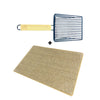Selecting the right bedding for your chinchilla, or "chins," as they’re affectionately called, is a vital part of ensuring their health and happiness. But, with so many bedding options available, finding the perfect match can seem daunting. Each type of bedding offers different advantages and disadvantages, and the ideal choice often hinges on your pet's unique needs and habits.
We've thoroughly researched the most popular bedding types with an emphasis on safety, comfort, and practicality. Our aim is to help you make an informed decision that keeps your chinchilla cozy and content. This guide will outline the key characteristics of various bedding options and highlight potential concerns, ensuring your furry friend enjoys the best environment possible.
Chinchillas need enough bedding to stay warm, and because they’re nibblers, they need a bedding they can safely chomp on. Luckily, there are some great options for these little, furry creatures.
|
Option |
Pros |
Cons |
|
Wood* (including Aspen and Douglas Fir) |
· Safe · Sustainable · Low dust · Absorbent · Great odor control |
· Some chinchillas find this bedding uncomfortable; you’ll know this is the case if your animal tries to burrow to the bottom of the cage |
|
Paper |
·Soft and comfortable · Widely available · Absorbent · Sustainable |
· Poor odor control |
|
Pine Shavings |
·If kiln-dried, these are absorptive and phenols are removed |
· If not kiln-dried, pine shavings can irritate your chinchilla |
|
Hemp |
· Excellent for tunneling/burrowing · Absorbent · Sustainable · Low dust · Naturally antibacterial and antimicrobial |
· Can be difficult to find in stores as it’s a seasonal crop · Expensive |
|
Hay |
· Allows chewing if soft · Chinchillas like sleep areas lined with soft hay |
· Sharp hay can harm small animals |
|
Bedding to Avoid |
· Cedar, which has phenols and other toxins · Scented wood shavings, which can stress a chinchilla's respiratory tract and ingestion can cause liver or kidney disease · Anything bedding that is scented or synthetic ·Corncob, which molds easily when wet and can cause intestinal blockages if ingested · Cat-specific litter, particularly any with tiny pellets or heavy scents, which can irritate your small animal or could be eaten and cause blockages |
|
*Ensure any wood bedding is phenol-free. If phenols are present, they can irritate the skin and respiratory system of your small pet and cause issues for humans, too. Wood that is kiln-dried should be phenol free.
Of course, just like humans, your small animals have innate preferences. Even if you’ve done your homework and chosen what you believe is the perfect bedding for your pet, they might have other ideas. Your furry friend will continue to show its personality, and you can keep trying until you find the best option for your little pal!
How much bedding do you need?
Below are Catalyst’s recommendations for the amount of bedding each type of small animal needs. Of course, use your own judgment as you get to know your pet’s preferences!
|
Small Animal |
Gerbil or Hamster |
Chinchilla or Ferrett |
Guinea Pig |
Rabbit |
Rat or Mouse |
|
Habitat Size |
23” x 19” |
25” x 25” |
48” x 24” |
54” x 27” |
20” x 14” |
|
Bedding Depth |
4” – 6” |
2” – 3” |
2” – 3” |
2” – 3” |
2” – 3” |
|
Amount Needed |
43L |
35L |
57L |
72L |
20L |














